In a longer maturity fund, the adverse impact of yields moving up is higher.
We all know that interest rates are set to move up, rate cycle reversal is a matter of time. Since interest rates and bond prices move inversely, as long as interest rates are moving up, returns from bond funds will not be good. There is another popular practice, of looking at the portfolio YTM (yield to maturity, the accrual level of the bonds in the portfolio) and taking it as a proxy for the expected return from a debt fund. Now let us put all these together.
Rate upmove
When interest rates move up in 2022, the portfolio YIM of debt funds will move up. So when will the benefit of higher yields (interest rates) in the market flow to investors? Herein comes the relevance of debt fund portfolio reset.
The coupon rate of a bond is a constant and is not contingent upon interest rate movements in the market. If the face value and issue price of a bond is say Rs. 100 and the coupon rate (interest rate) is 5 per cent, interest payout is T5, no conditions at – SMART TIP tached. Also, Interest rates are on let’s say the lower side now, weighted av but gradually the erage TIM of accrual level of debt all the bonds funds will normalise in the portfolio of a debt fund is 5 per cent. Thereafter, interest rates in the market move up and the YTM for daily valuation of NAV moves up to say 6 per cent. The relevance of this is, that the price of the bonds for daily NAV computation, will be taken as that corresponding to 6 per cent, which will be a lower than the face value, since yield and price move inversely.
But, as the coupon accrual in the fund portfolio is happening at S per cent and not 6 per cent, how does one reconcile that?
Portfolio maturity matters
Over a period of time, as and when the instruments in the portfolio mature, the face value comes back, and the portfolio gets the benefit. How? Let us say for the bond with a face value of Rs. 100 that was being valued at Rs. 99 due to yields moving up, on maturity, the portfolio gets the benefit of tt, to the extent of holding in the portfolio. Hence the whole question is, what is the length of the cycle for the entire portfolio of bonds or other instruments to mature? The indication folio maturity is subject to change due maturity fund, it takes that much longer, for that is the portfolio maturity of the to maturities and purchase of fresh in- while the adverse impact of yields movfund, which is the weighted average of instruments, we get the indication up is higher all the instruments in the portfolio, In a Liquid Fund, if the portfolio in which we can refer to in the fund maturity is say 1 month, in a month or so, the portfolio gets reset. In a longer Maturity fund, it takes that much longer, while the adverse impact of yields moving up is higher.


